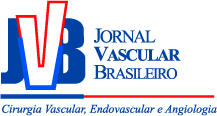Tratamento endovascular da estenose da artéria renal em rim único
Endovascular treatment of renal stenosis in solitary kidney
Ana Terezinha Guillaumon; Eduardo Faccini Rocha; Charles Angotti Furtado de Medeiros
Resumo
Palavras-chave
Abstract
Keywords
References
Scoble J, Maher E, Hamilton G, Dick R, Sweny P, Moorhead JF. Atherosclerotic renovascular disease causing renal impairment: a case for treatment. Clin Nephrol. 1989;31:119-22.
Olin JW, Melia M, Young JR, Graor RA, Risius B. Prevalence of atherosclerotic renal artery stenosis in patients with atherosclerosis elsewhere. Am J Med. 1990;88:46N-51N.
Zierler RE, Bergelin RO, Isaacson JA, Strandness DE. Natural history of atherosclerotic renal stenosis: a prospective study with duplex ultrasonography. J Vasc Surg. 1994;19:250-7.
Wright JR, Shurrab AE, Cheung C. A prospective study of determinants of renal function outcome and mortality in atherosclerotic renovascular disease. Am J Kidney Dis. 2002;39:1153-61.
Suresh M, Laboi P, Mamtora H, Kalra PA. Relationship of renal dysfunction to proximal artery disease severity in atherosclerotic renovascular disease. Nephrol Dial Transplant. 2000;15:631-6.
Hunt JC, Strong CG. Renovascular hypertension: Mechanisms, natural history and treatment. Am J Cardiol. 1973;32:562-74.
Davis BA, Crook JE, Vestal RE, Oates JA. Prevalence of renovascular hypertension in patients with grade III or IV hypertensive retinopathy. N Engl J Med. 1979;301:1273-6.
Axelrod DA, Fendrick AM, Carlos RC. Percutaneous stenting of incidental unilateral renal artery stenosis: decision analysis of cost costs and benefits. J Endovasc Ther. 2003;10:546-56.
Ayerdi J, Hodgson KJ. Ballon angioplasty and stenting for renovascular occlusive disease. Persp Vasc Surg Endovasc Ther. 2004;16:25-38.
Sahin S, Cimsit C, Andaç N, Baltacioglu F, Tuglular S, Akoglu E. Renal artery stenting in solitary functioning kidneys: technical and clinical results. Eur J Radiol. 2006;57:131-7.
Shannon HM, Gillespie IN, Moss JG. Salvage of the solitary kidney by insertion of a renal artery stent. AJR Am J Roentgenol. 1998;171:217-22.
Cioni R, Vignali C, Petruzzi P. Renal stenting in patients with a solitary functioning kidney. Cardiovasc Intervent Radiol. 2001;24:372-7.
Gruntzig A, Kuhlmann U, Vetterr W, Lütolf U, Meier B, Siegenthaler W. Treatment of renovascular hypertension with percutaneous transluminal dilatation of a renal artery stenosis. Lancet. 1978;1:801-2.
Scolari F, Ravani P, Pola A. Predictors of renal and patient outcomes in atheroembolic renal disease: a prospective study. J Am Soc Nephrol. 2003;14:1584-90.
Mukherjee D, Bhatt DL, Robbins M. Renal artery end-diastolic velocity and renal artery resistance index as predictors of outcome after renal stenting. Am J Cardiol. 2001;88:1064-6.
Chatziiannou A, Mourikis D, Agroyannis B. Renal artery stenting for renal insufficiency in solitary kidney in 26 patients. Eur J Vasc Endovasc Surg. 2002;23:49-54.
Sivamurthy N, Surowiec SM, Culakova E. Divergent outcomes after percutaneous therapy for symptomatic renal artery stenosis. J Vasc Surg. 2004;39:565-74.
Beutler JJ, Van Ampting JM, Van De Ven PJ. Long-term effects of arterial stenting on kidney function for patients with ostial atherosclerotic renal artery stenosis and renal nsufficiency. J Am Soc Nephrol. 2001;12:1475-81.
Pillay WR, Kan YM, Crinnion JN, Wolfe JH. Prospective multicentre study of the natural history of atherosclerotic renal artery stenosis in patients with peripheral vascular disease. Br J Surg. 2002;89:737-40.
Cherr GS, Hansen KJ, Craven TE. Surgical management of atherosclerotic renovascular disease. J Vasc Surg. 2002;35:236-45.



